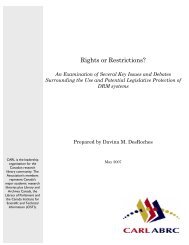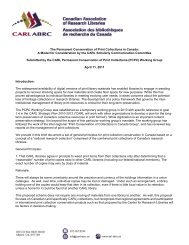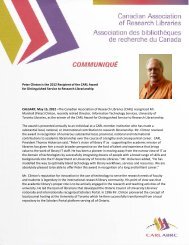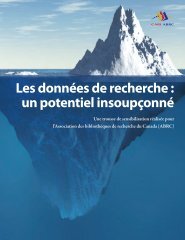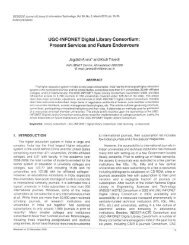PDF - CARL - ABRC
PDF - CARL - ABRC
PDF - CARL - ABRC
Create successful ePaper yourself
Turn your PDF publications into a flip-book with our unique Google optimized e-Paper software.
Launched on April 28, 2010, PubMed Central Canada, the result of collaboration between CIHR, the<br />
Canada Institute of Scientific and Technical Information (CISIT) and the [U.S.] National Library of<br />
Medicine, will help researchers with CIHR funding to comply with the Policy on Access to Research<br />
Outputs via the PMC manuscript submission system. PMC Canada will provide Canadians a freely<br />
accessible national digital repository of the latest peer‐reviewed health and life sciences literature at<br />
their fingertips. It is a vital part of Canada’s research infrastructure giving researchers desktop access to<br />
a searchable, permanent and freely accessible archive of Canadian health research enabling them to<br />
translate that knowledge into solutions to important health issues. PMC Canada builds on PubMed<br />
Central (PMC), the archive developed by the US National Library of Medicine, and joins UK PubMed<br />
Central (UKPMC) as a member of the larger PMC International network. 27<br />
Ensuring optimal researcher uptake of the innovative infrastructure and services that are being created<br />
to broaden the reach of their research will depend, in part, on successful educational/outreach<br />
initiatives to inform them of their rights as authors and of the options and best practices available to<br />
them. The Canadian Association of Research Libraries has produced a suite of communications<br />
materials detailing the advantages of open access 28 . The Canadian Association of University Teachers<br />
(CAUT) issued an important intellectual property advisory in the summer of 2008 to assist academic staff<br />
in retaining copyright ownership in the articles they publish in journals. Without copyright ownership,<br />
academic staff risk losing control of their own work and may not be entitled to email it to students and<br />
colleagues, use it for course reserve purposes, place it in an institutional repository, publish it in an open<br />
access journal or include it or parts of it in subsequent works. The CAUT IP advisory stresses the point<br />
that “Journals require only authors’ permission to publish an article, not a wholesale transfer of the full<br />
copyright interest. To promote scholarly communication, autonomy, integrity and academic freedom,<br />
and education and research activities more generally, it is important for academic staff to retain<br />
copyright in their journal articles. 29 ”<br />
27<br />
PubMed Central Canada http://pubmedcentralcanada.ca/<br />
28<br />
Canadian Association of Research Libraries, Greater Reach for Your Research: Resources for Authors<br />
http://www.carl‐abrc.ca/projects/author/author‐e.html<br />
29<br />
Retaining Copyright in Journal Articles, CAUT Intellectual Property Advisory, July 2008<br />
http://www.caut.ca/uploads/IP‐Advisory1‐en.pdf<br />
10




